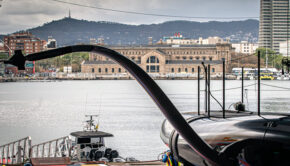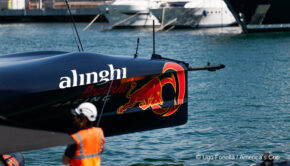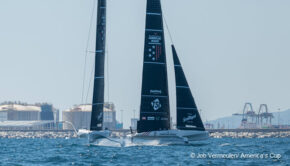History of America’s Cup arbitration
Published on April 6th, 2022
While the America’s Cup is intended to be a friendly competition between foreign countries, the pursuit of the prize tends to bring out the heat in people. In this report, Hesketh Henry provides the history of arbitrating the America’s Cup:
In 1970, after Australia was controversially disqualified in Race 2 of AC21, Sir Frank Packer “raged that protesting to the New York Yacht Club was like complaining to your mother-in-law about your wife”. Until then, the NYYC assumed the role of both competitor and referee in the America’s Cup.
Realizing this was no longer acceptable in modern sport, independent juries were subsequently appointed to resolve racing disputes. Even then, it took another 20 years until AC28 in 1992 before on-the-water umpiring was introduced.
While that addressed racing issues, it left unanswered the resolution of “on shore” disputes, which are primarily governed by an 1887 “Deed of Gift”. Although competitor disagreements had been a consistent feature since the Cup’s inception, for the first 136 years these were dealt with in a largely Corinthian fashion.
Innocence was shattered in 1988 with New Zealand’s “big boat” challenge, which Dennis Connor defended in a catamaran, and the resulting litigation through the New York courts. This produced a body of America’s Cup jurisprudence but was an ugly spectacle that led to a re-think of, among other things, dispute resolution for the event.
Only once since then has the Cup been back in the courts when Golden Gate Yacht Club (GGYC, Oracle) successfully disputed the legitimacy of Société Nautique de Genève’s (SNG, Alinghi) Challenger of Record for AC33, Club Náutico Español de Vela (CNEV). Otherwise, all other non-racing disputes have, broadly speaking, been resolved by bespoke dispute resolution bodies / methods specified in the protocol for each edition of the Cup.
Now approaching the 37th America’s Cup, this article summarizes the evolution of dispute resolution in the modern America’s Cup and notes key features for the next edition. Despite being slow to embrace suitable (or fair) ways of settling disagreements, the Cup now offers lessons on adaptable dispute resolution, which the commercial world might learn from.
Deed of Gift and Protocols
It is worth noting, for context, that a unique and perhaps surprising feature of the America’s Cup is that it is a challenger driven event. The Cup was gifted to the NYYC in 1857 by the owners of America, which first won the Cup at Cowes, England, as a “perpetual Challenge Cup”.
Following the original Deed of Gift (1857 Deed), two subsequent deeds were issued in 1882 (1882 Deed) and 1887 (1887 Deed) providing more prescriptive rules for the event. It is widely accepted that the Cup is now held and governed under the 1887 Deed.
The first valid challenger, known as the “Challenger of Record”, has the right to negotiate mutual consent terms (eg class, venue, dates, etc) for that edition, which are documented in a “protocol”. If there are multiple challengers, every other challenger must accept the protocol to compete in the challenger selection-series and earn the right to race the Defender for the Cup. As explained below, this has dispute resolution implications.
Usually, the Defender and Challenger of Record will reach agreement. This is helped by the fact that, since 1988, the Challenger of Record is pre-arranged with the Defender and their challenge is issued – literally – as the winning vessel crosses the line to ensure they are the first in time. This pre-planning can still come unstuck, however, if the challenge does not comply with the requirements set out in the Deed of Gift.
If the Defender and Challenger of Record cannot reach agreement, the default terms in the Deed of Gift will apply. Matches sailed under those conditions, as occurred in 1988 for AC27 and 2010 for AC33, are known as “DOG Matches” and are rare. The default terms do not include dispute resolution provisions, meaning any disputes in relation to a DOG Match may be resolved by the courts, which, as AC27 and AC33 showed, is far from satisfactory.
Modern America’s Cup Dispute Resolution
With that background, the evolution of dispute resolution in the America’s Cup over the last 30 years is summarized below:
Trustee Committee
For AC28 in 1992 and AC29 in 1995 (which New Zealand won), the San Diego Yacht Club (SDYC) introduced a Trustee Committee. This comprised a representative from each of the current and past holders of the Club (i.e. the NYYC, Royal Perth Yacht Club, SDYC) and was the first ad hoc dispute resolution body for the America’s Cup. Broadly speaking, the three-person committee could rule on anything other than measurement and racing issues, which were dealt with respectively by independent measurers and an International Jury.
Although an improvement on litigation, the Trustee Committee was open to criticism for a lack of independence (especially by teams outside of the US or Australia), and there seems to have been doubt as to whether it qualified as arbitration with the attendant protections and benefits arbitration otherwise offers.
America’s Cup Arbitration Panel
After Team New Zealand won the Cup in 1995, the Royal New Zealand Yacht Squadron (RNZYS) dispensed with the Trustee Committee and replaced it with an arbitral body for AC30 in 2000 and AC31 in 2003.
The arbitral body, known as the “America’s Cup Arbitration Panel” (ACAP), comprised five members. The Defender and Challenger of Record each selected two members, and those four then selected the fifth member who was also the chair.
Panel members had to meet broad criteria for section (eg possessing knowledge of the Cup and yacht racing, and be fair minded and of good judgment), but could be from any country including those participating. These criteria have become standard, with only minor adjustments from protocol-to-protocol.
Like the Trustee Committee, the ACAP could rule on anything except measurement and racing issues. However, aside from its selection and composition, there were some key differences.
In addition to resolving disagreements, the ACAP could issue “advisory opinions” for any teams who sought a clarification without requiring a crystallized dispute. The advisory opinions, which was an innovation at the time, were binding on all competitors provided the facts on which they were based were correct and complete.
For disputes, ACAP decisions were final and could not be appealed. Teams were also expressly prohibited from litigating disputes through the courts and would be ineligible to compete if they did so. Entrenching this further, acceptance of all protocol terms was a condition of entry, which has been repeated in subsequent editions of the Cup. These restrictions are now commonplace in Cup protocols.
Questions of independence also arose with the ACAP, however. For example, for AC30, the Defender (RNZYS) selected two New Zealand lawyers and the Challenger of Record (NYYC) selected two Americans (one a New York lawyer, and both past commodores). Nevertheless, the ACAP seemed to work reasonably well and has become the benchmark for America’s Cup dispute resolution.
America’s Cup Jury
After Alinghi won the Cup in 2003, it combined the arbitration panel and international jury into a singly dispute body, known as the “America’s Cup Jury” (ACJ), for AC32 in 2007. The ACJ acted both as a jury on racing issues and as an arbitral body on other disputes
The ACJ comprised five members appointed by ISAF (now World Sailing) in consultation with the Defender and Challenger Commission (in practice, the Challenger of Record). This made the appointment process more balanced, though unsurprisingly the composition of the ACJ had more European representation than the ACAPs or Trustee Committees.
The ACJ could determine any disputes except (a) measurement issues, which were the responsibility of a Measurement Committee, and (b) certain commercial matters. As with the ACAP, its decisions were final and binding, with no appeal rights. The arbitration was seated in New York, rather than Geneva, presumably because the Cup was understood to be held subject to New York laws.
Despite their hostilities, after GGYC (Oracle) defeated SNG (Alinghi) in AC33 (2010), they persisted with an ACJ for AC34 (2013) in San Francisco. This was the Jury that penalized GGYC two points and imposed sanctions after team members illegally modified their AC World Series yacht.
Arbitration Panel returns
After successfully defending the Cup against New Zealand in 2013, GGYC switched back to the split Jury / Arbitration Panel model first adopted by the RNZYS for AC35 (2017) in Bermuda. One noticeable difference, however, was that the panel reduced from five to three.
There were also more procedural rules and guidelines than before. These included empowering the panel chair to mediate deadlocks between the Defender and Challenger of Record without disqualifying the chair from subsequently arbitrating the same issue if it remained in dispute.
The Arbitration Panel for AC35 remained somewhat in the shadows. Amendments to the protocol kept the composition of the panel, the disputes it heard, and the decisions it gave, confidential. At least one commentator likened it to a “modern-day ‘star-chamber’”.
It was this panel that allegedly awarded Emirates Team New Zealand compensation after the America’s Cup Event Authority took the America’s Cup Qualifiers event off Auckland. However, this has never been publicly confirmed.
Since regaining the Cup in 2017, the RNZYS has continued with a separate Arbitration Panel for AC36 in 2021 and AC37 in 2024, including following the GGYC’s lead in limiting it to three members. In contrast to SNG’s protocols, arbitration is seated in Auckland and subject to New Zealand laws – regardless of the venue for the Cup or any associated build-up events.
America’s Cup 37
The dispute resolution provisions in the protocol for AC37 deserve some closer attention, and not just because of the sensitivity surrounding the choice of venue. Notable features include:
• A broad jurisdiction. This includes the power to impose wide-ranging penalties / sanctions, and for a panel member to mediate any dispute (on request or of their own motion) and not be precluded from then arbitrating it.
• The introduction of a fast-track process to triage disputes and determine them quickly if they are capable of a swift resolution. The precise procedure is left for the panel to decide subject to following certain principles. While past panels have had freedom to develop their own procedures, this is the first time a protocol has expressly provided for a fast-track process.
• A ten-day time limit for applying to the panel, which starts when teams ought reasonably to have become aware of an issue. This is presumably to stop “banking” disputes and raising them later strategically. Admittedly, it is not the first time this measure has been adopted, and it is less strict than the 7-day limit in AC35.
• Greater transparency. Proceedings will remain confidential, although the panel has a discretion to override this if just and equitable. However, like the last Cup, the decisions will be published unless there are exceptional circumstances.
Broader commercial application?
Arbitration is widely used to resolve commercial disputes, and is particularly common in some sectors like construction, technology, and transport. It tends to be favored for its confidentiality, procedural flexibility, and the ability to appoint a decision maker with relevant expertise. ADR (especially mediation) is also extensively used to reach settlements, but typically occurs separately and in parallel to arbitral proceeding.
These dispute resolution methods may, however, be applied to other contexts, such as sport where there can be more flexibility to tailor and even combine different processes for greater efficiency, as the modern Cup protocols illustrate.
By commercial standards, many features of America’s Cup dispute resolution methods are unconventional. These include overriding traditional notions of independence, permitting advisory opinions, imposing time-limits on making applications, allowing dual consensual, and determinative roles, publishing decisions, and removing appeal rights and sanctioning non-compliance.
Yet, ironically, these features appear to have been largely successful in what is otherwise a contentious and high stakes contest. There is much to be said for having a standing dispute resolution body made up of subject matter experts to mediate or determine issues quickly, which an America’s Cup arbitration panel effectively is.
Similar dispute boards are sometimes operated on large construction and technology projects, usually with success. Where this is not economic, the Cup protocols show how differences can potentially be triaged and resolved more efficiently and timeously (arguably more so than Construction Contracts Act adjudications, for example). The commercial world might learn from this by being more adaptive when it comes to resolving disputes.









 We’ll keep your information safe.
We’ll keep your information safe.